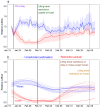Effect of non-pharmaceutical interventions to contain COVID-19 in China
- PMID: 32365354
- PMCID: PMC7116778
- DOI: 10.1038/s41586-020-2293-x
Effect of non-pharmaceutical interventions to contain COVID-19 in China
Abstract
On 11 March 2020, the World Health Organization (WHO) declared coronavirus disease 2019 (COVID-19) a pandemic1. The strategies based on non-pharmaceutical interventions that were used to contain the outbreak in China appear to be effective2, but quantitative research is still needed to assess the efficacy of non-pharmaceutical interventions and their timings3. Here, using epidemiological data on COVID-19 and anonymized data on human movement4,5, we develop a modelling framework that uses daily travel networks to simulate different outbreak and intervention scenarios across China. We estimate that there were a total of 114,325 cases of COVID-19 (interquartile range 76,776-164,576) in mainland China as of 29 February 2020. Without non-pharmaceutical interventions, we predict that the number of cases would have been 67-fold higher (interquartile range 44-94-fold) by 29 February 2020, and we find that the effectiveness of different interventions varied. We estimate that early detection and isolation of cases prevented more infections than did travel restrictions and contact reductions, but that a combination of non-pharmaceutical interventions achieved the strongest and most rapid effect. According to our model, the lifting of travel restrictions from 17 February 2020 does not lead to an increase in cases across China if social distancing interventions can be maintained, even at a limited level of an on average 25% reduction in contact between individuals that continues until late April. These findings improve our understanding of the effects of non-pharmaceutical interventions on COVID-19, and will inform response efforts across the world.
Conflict of interest statement
The authors declare no competing interests.
Figures












Update of
-
Effect of non-pharmaceutical interventions for containing the COVID-19 outbreak in China.medRxiv [Preprint]. 2020 Mar 6:2020.03.03.20029843. doi: 10.1101/2020.03.03.20029843. medRxiv. 2020. Update in: Nature. 2020 Sep;585(7825):410-413. doi: 10.1038/s41586-020-2293-x. PMID: 32511601 Free PMC article. Updated. Preprint.
References
-
- World Health Organization. WHO Director-General's opening remarks at the media briefing on COVID-19 - 11 March 2020. 2020 https://www.who.int/dg/speeches/detail/who-director-general-s-opening-re....
-
- Novel Coronavirus Pneumonia Emergency Response Epidemiology Team. The epidemiological characteristics of an outbreak of 2019 novel coronavirus diseases (COVID-19) in China. Chinese Journal of Epidemiology. 2020;41:145–151. - PubMed
-
- World Health Organization. Report of the WHO-China Joint Mission on Coronavirus Disease 2019 (COVID-19) 2020 https://www.who.int/docs/default-source/coronaviruse/who-china-joint-mis....
-
- Baidu Migration. 2020 https://qianxi.baidu.com/
Publication types
MeSH terms
Grants and funding
LinkOut - more resources
Full Text Sources
Medical
Miscellaneous

